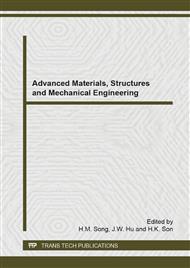p.555
p.559
p.564
p.570
p.574
p.580
p.585
p.591
p.597
New Insight Technique for Synthesis of Silica Gel from Rice Husk Ash by Using Microwave Radiation
Abstract:
Silica gel is the chemical substance that has many good advantages such as absorbed moisture, porosity, small diameter, high surface area, and lightweight. It was synthesized by using rice husk ash via sol – gel heating in the microwave technique. The objectives in this work compose of synthesis silica gel by using the microwave technique before characterizatization. This raw material was archived from rice husk ash, obtained from agricultural waste. The silica gel, synthesized by conventional method (CVM) and commercial silica gel (COM), was also studied for comparison purposes. The results showed that successfully synthesized the silica gel by sol - gel technique using microwave. The XRD pattern of silica gel enhanced from this method was not sinificantly different as compared with CVM and COM methods. And the physical properties of this technique could be debated. The particle size of silca gel was determined by zetasizer and it was approxmately 50-70 nm. The pore size diameter, pore volume, and specific surface area of silica gel were calculated by Flowsorb II and a Quantachrome Autosorp-1. The pore size diameter, pore volume, and specific surface area of silica gel are 10-30 nm, 0.7-1.0 cm3/g, and 400-700 m2/g, respectively. Consequently, this work is considered to be the waste to make useful, and a great way to save energy and time in the silica gel synthesis.
Info:
Periodical:
Pages:
574-579
Citation:
Online since:
September 2014
Authors:
Keywords:
Price:
Сopyright:
© 2014 Trans Tech Publications Ltd. All Rights Reserved
Share:
Citation:


